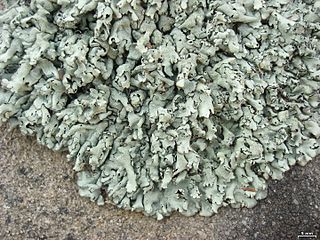
Parmelia is a genus of medium to large foliose lichens. It has a global distribution, extending from the Arctic to the Antarctic continent but concentrated in temperate regions. There are about 40 species in Parmelia. In recent decades, the once large genus Parmelia has been divided into a number of smaller genera according to thallus morphology and phylogenetic relatedness.

The Parmeliaceae is a large and diverse family of Lecanoromycetes. With over 2700 species in 71 genera, it is the largest family of lichen-forming fungi. The most speciose genera in the family are the well-known groups: Xanthoparmelia, Usnea, Parmotrema, and Hypotrachyna.

Xanthoparmelia is a genus of foliose lichen in the family Parmeliaceae. Xanthoparmelia is synonymous with Almbornia, Neofuscelia, Chondropsis, Namakwa, Paraparmelia, and Xanthomaculina. This genus of lichen is commonly found in the United States, as well as Australia, New Zealand and Ecuador.
Psiloparmelia is a genus of lichen belonging to the family Parmeliaceae. It contains 13 Southern Hemisphere species, most of which are found growing on rocks at high elevations in South America. There are several characteristic features of the genus that are used to distinguish it from the morphologically similar genera, such as Arctoparmelia, Flavoparmelia, and Xanthoparmelia. These include a dark, velvety lower thallus surface that usually lacks rhizines, a negative test for lichenan, and a high concentration of usnic acid and atranorin in the cortex.

Xanthoparmelia lineola, commonly known as the tight rock-shield, is a foliose lichen species in the genus Xanthoparmelia. It is a common species with a temperate distribution. Found in North America and South Africa, it grows on rocks.
Josef Hafellner is an Austrian mycologist and lichenologist. He was awarded the Acharius Medal in 2016 for his lifetime contributions to lichenology. Before his retirement, he was a professor at the Karl-Franzens-Universität in Graz. Hafellner started developing an interest in lichens while he was a student at this institution, studying under Josef Poelt. He earned a master's degree in 1975 and a PhD in 1978, defending a doctoral thesis about the genus Karschia. In 2003, Hafellner received his habilitation. By this time, he had studied with French lichenologist André Bellemère (1927–2014) at Saint-Cloud, where he learned techniques of transmission electron microscopy and how their application in studying asci could be used in lichen systematics. His 1984 work Studien in Richtung einer natürlicheren Gliederung der Sammelfamilien Lecanoraceae und Lecideaceae has been described as "probably the single most influential publication in lichen systematics in the latter half of the 20th century".
Xanthoparmelia salazinica is a species of lichen in the family Parmeliaceae. Found in South Africa, it was described as a new species in 1989 by American lichenologist Mason Hale. He classified it in Karoowia, a genus that has since been placed in synonymy with Xanthoparmelia following molecular phylogenetic analysis published in 2010.
Henricus (Harrie) Johannes Maria Sipman is a Dutch lichenologist. He specialises in tropical and subtropical lichens, and has authored or co-authored more than 250 scientific publications. He was the curator of the lichen herbarium at the Berlin Botanical Garden and Botanical Museum from 1983 until his retirement in 2010.

Xanthoparmelia cumberlandia is a lichen which belongs to the Xanthoparmelia genus. It is also known as a member of the rockfrong lichens due to its coloration.

Xanthoparmelia plittii is a lichen which belongs to the Xanthoparmelia genus.

Xanthoparmelia angustiphylla is a foliose lichen that belongs to the genus Xanthoparmelia.

Xanthoparmelia ajoensis is a foliose lichen that belongs to the genus Xanthoparmelia. The lichen is uncommon and is listed as vulnerable by the Nature Conservatory.

Xanthoparmelia joranadia is a lichen which belongs to the Xanthoparmelia genus. The lichen is rare and is listed as imperiled by the Nature Conservatory. It is noted for being similar to Xanthoparmelia arida and Xanthoparmelia lecanorica.
Xanthoparmelia arida is a lichen which belongs to the Xanthoparmelia genus. The lichen is an arid shield lichen and is uncommon it is listed as apparently secure by the Nature Conservatory. It is noted for being similar to Xanthoparmelia joranadia.
Xanthoparmelia lecanorica is a foliose lichen that belongs to the genus Xanthoparmelia. It is noted for being similar in appearance and has often been misidentified as Xanthoparmelia arida.

Xanthoparmelia idahoensis is a lichen which belongs to the Xanthoparmelia genus. The lichen is uncommon and is listed as endangered by the Nature Conservatory.
Xanthoparmelia montanensis is a lichen which belongs to the Xanthoparmelia genus, it is also known as the Montana Rock-shield Lichen.
Xanthoparmelia neowyomingica is a rock shield lichen which belongs to the Xanthoparmelia genus. The lichen is uncommon and is listed as endangered by the Nature Conservatory.
Xanthoparmelia schmidtii is a lichen which belongs to the Xanthoparmelia genus. The lichen is uncommon and is listed as endangered by the Nature Conservatory.
Xanthoparmelia camtschadalis is a foliose lichen that belongs to the genus Xanthoparmelia. The lichen is also known as the Kamchatka rock-shield lichen. The lichen was formally described as a new species in 1974 by American lichenologist Mason Hale.








